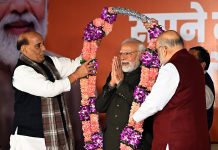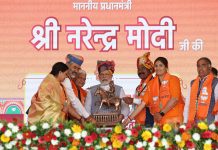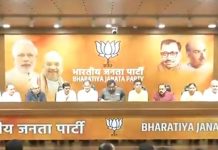The demand to do away with EVMs is supported by most non-NDA political parties and opposed by BJP as well as the Election Commission of India (ECI). Alluding to apprehensions over alleged misuse of EVMs to manipulate the outcome contrary to the popular verdict, Congress resolution has called upon the ECI to revert to the old practice of paper ballot to ensure credibility of the electoral process. The issue of EVMs being tampered with in India has been raked up by several political parties from time to time and in 2017 it had seemingly reached its zenith. While conceding that this debate is linked to the core emotion of democracy that makes it no ordinary issue, one critic has opined that the voices alleging tampering with the very fabric of democracy have instilled a fear even among the common populace — “could it be that our elections are rigged?”

Backdrop to the debate
According to the official website of the ECI, EVMs were used on experimental basis for the first time in 16 Assembly Constituencies in Madhya Pradesh (5), Rajasthan (5) and NCT of Delhi (6) in elections to the respective Legislative Assemblies held in November,1998. However, a losing candidate filed a plea in 1999 challenging the role of EVMs in the Yelahanka Parliamentary constituency in Karnataka, which was rejected by the Karnataka High Court in its verdict in 2005, by stating that EVMs were a great achievement in the country and ruled out that the machines were tamper-proof. A petition against EVMs in 2004 filed before the Delhi High Court, alleging that the machines were tampered with to favour the UPA in election results, was rejected as the HC found no merit in the petition.
While alleging that EVMs were not ‘foolproof’ in the 2009 Lok Sabha Polls, veteran BJP leader LK Advani had suggested that the Election Commission revert to ballot papers. The Left parties and BSP also extended their support to this demand. In the wake of some petitions challenging the use of EVMs in elections before it, the Supreme Court on October 9, 2013, had asked the Election Commission to introduce in a phased manner the paper trail in EVMs for the 2014 Lok Sabha elections, saying “it is an indispensable requirement of free, fair and transparent” polls which will restore confidence of the voters. The apex court also directed introduction of Vote Verifier Paper Audit Trail (VVPAT) system with EVMs.
The resounding victory of the BJP in the 2014 General Elections again revived the issue of faulty EVMs. The year 2017 witnessed sharpened focus on the issue starting with the BMC elections in which many losing candidates claimed that EVMs were manipulated in BJP’s favour and demanded re-polling with ballot papers. The debate on faulty EVMs gathered momentum once again in the aftermath of the declaration of results of assembly elections in Uttar Pradesh, Punjab, Uttarakhand, Goa and Manipur.
Following BJP’s landslide victory in Uttar Pradesh, BSP supremo Mayawati took up the issue of EVM tampering and demanded investigation on voting machines. Even Samajwadi Party came on board with BSP. Mayawati even moved court on the issue, saying that the BJP tampered with the EVMs in at least 250 seats out of 403 in the Assembly polls. Subsequently, a two-judge bench issued notices to the Centre and the ECI asking them to respond to the plea challenging the use of EVMs without paper trail. Aam Aadmi Party alleged manipulation of EVMs after BJP’s win in the 2017 Delhi municipal body polls. A plea by Congress to issue directions to the Election Commission to count and cross verify the paper trail with EVM votes in Gujarat was rejected by the Supreme Court on December 15, 2017.
Despite Election Commission’s reiteration time and again that EVMs cannot be tampered with, Opposition parties have frequently insisted on doing away with the EVMs and as such the controversy refuses to die down. In order to allay concerns and confront allegations of voter fraud by running through the administrative and technological safeguards instituted to keep EVMs and the voting process tamper-proof, the ECI has sought to issue formal direction to use Voter Verifiable Paper Audit Trail (VVPAT) machines in all future Lok Sabha and Assembly elections.
Situation in Other Democracies
Electronic technologies began to appear in the 1960s; nonetheless, it was the 1990s and the first decade of the 21st century that an increasing number of countries around the world started to adopt technologies such as DRE voting machines, ballot scanning machines and the internet. Some experts point out that very different trends are seen in different regions of the globe. Electronic voting was introduced in many countries. But serious doubts were soon raised about the security, accuracy, reliability and verifiability of electronic elections.
EVMs have been termed as unconstitutional and banned in Germany. The Netherlands banned the use of EVMs in 2008 stating that they lack transparency. Ireland scrapped the electronic voting system citing it to lack of trust and transparency in the voting machine.
In January 2016, the UK Parliament revealed that it has no plans to introduce electronic voting for statutory elections, either using electronic voting in polling booths or remotely via the internet. While France has chosen to vote via the internet, EVMs have not been used in France.
Italy has chosen to go back to ballot paper as it is easy to manage and cheaper. A report published in Time magazine quotes the US Election Assistance Commission Chairman Tom Hicks saying that the “primary reasons” paper ballots are used in most states are “security and voter preference”.
Undoubtedly, many European countries have banned or refrained from using EVMs; there are others who have taken a systematic approach and backed the use of EVMs with paper ballots. According to some experts, in Venezuela EVMs are used on a large scale but are backed by paper trails of the votes because this simple step helps the government to regularize and check the authenticity of votes and avoid any discrepancies.
Way Forward
The ECI intends to introduce VVPAT machines with EVMs in all constituencies during the 2019 general elections with the hope that it would allay some doubts raised by naysayers and ensure transparency and confidence in the electoral process.
In early March this year, the Central government informed the apex court that all political parties were opposed to the use of ‘totalizer’ in counting of votes by EVMs. A ‘totalizer’ is expected to mask voting patterns at counting stations, thus adding a layer of security to the process.
According to media reports, the EC first proposed the use of ‘totalizer’ in 2008. In 2015, the Law Commission in a report also supported the EC’s demand stating that “Using a totalizer would increase the secrecy of votes during counting, thus preventing the disclosure of voting patterns and countering fears of intimidation and victimisation”.
However, almost all political parties continue to have reservations about the totalizer.
In the wake of the fact that there is worldwide acceptance of the need for a paper trail in conjunction with EVMs, the introduction of VVPAT machines with EVMs, as proposed by the ECI can help in settling this controversy, provided political parties don’t make it a prestige issue owing to party rivalries.
letters@tehelka.com













